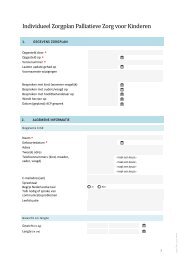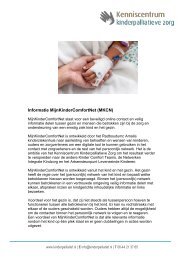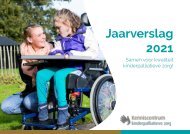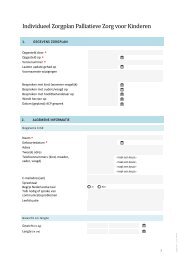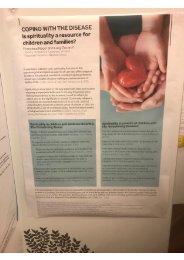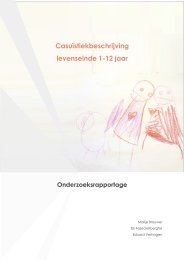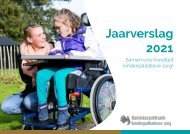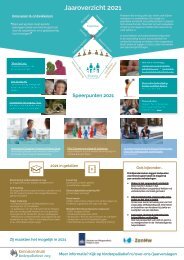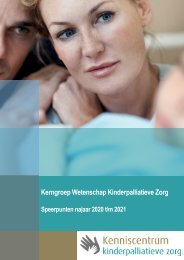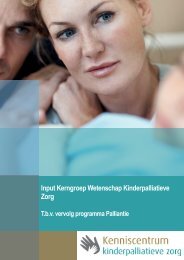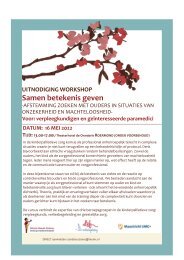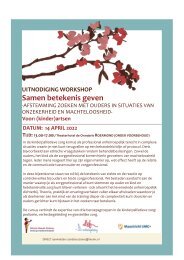Parental physical proximity in end-of-life care in the PICU
You also want an ePaper? Increase the reach of your titles
YUMPU automatically turns print PDFs into web optimized ePapers that Google loves.
Falkenburg et al<br />
Table 4. Quotes From Parents’ Interviews on “Physical Intimacy”<br />
Child’s Age<br />
Quote<br />
13 yr Mo<strong>the</strong>r: “We really crept <strong>in</strong>to <strong>the</strong> bed with her, to hold her.”<br />
2 wk Mo<strong>the</strong>r: “We washed her ourselves and put on her clo<strong>the</strong>s. It was wonderful. We f<strong>in</strong>ally had her without tubes.<br />
Free..”<br />
2 mo Fa<strong>the</strong>r: “After his death we thought: now what? The nurse said ( this was just natural for her): ‘My, what would you<br />
like? Shall we ba<strong>the</strong> him nicely, put on nice clo<strong>the</strong>s? What would you like?’ That was so nice, to have someth<strong>in</strong>g<br />
to grasp hold <strong>of</strong>. So we <strong>in</strong>deed ba<strong>the</strong>d him nicely. That sort <strong>of</strong> th<strong>in</strong>gs..”<br />
11 mo Mo<strong>the</strong>r: “We all held him <strong>in</strong> our laps, when he had died. He was dead and we held him!”<br />
3 mo Mo<strong>the</strong>r: “I wanted to ba<strong>the</strong> him myself. The children helped, <strong>the</strong>y wanted to. They touched him constantly. I let <strong>the</strong>m<br />
get on with it: if you want to, <strong>the</strong>n do it; if you don’t want it, you don’t need to. But <strong>the</strong>y just did. Until <strong>the</strong> last<br />
moment: just hold<strong>in</strong>g hands, yes. That I could do that myself, that was nice.”<br />
2 mo Mo<strong>the</strong>r (when her son’s dead body had to be transferred): “The nurse said: you may carry him if you want. I said:<br />
May I? Then he won’t go back to his cot. All <strong>the</strong>se weeks he had been laid up. Now f<strong>in</strong>ally I can hold him aga<strong>in</strong>.”<br />
13 yr After <strong>the</strong> child had died, her 16-year-old sister washed her, washed her hair… Fa<strong>the</strong>r: “Yes, and we helped. I<br />
brushed her teeth like I always used to do with <strong>the</strong> kids until a certa<strong>in</strong> age and it felt so good.”<br />
8 mo Mo<strong>the</strong>r: “And I sit with my little man on my lap and <strong>the</strong> nurse comes: I th<strong>in</strong>k it is over. I say: No, no way. He is still<br />
here. And next she listened ten times, and every time I shook my head: he is still here. Then I had a strange<br />
feel<strong>in</strong>g. Whe<strong>the</strong>r it was <strong>in</strong> my head, or that I really saw it, it was a k<strong>in</strong>d <strong>of</strong> light and it looked like hands… Then I<br />
said: It is over. And she came and said: My condolences, he has died.”<br />
9 mo Mo<strong>the</strong>r: “In <strong>the</strong> <strong>end</strong> he died quietly. On daddy’s lap. I said: He was born from my womb, he may go from<br />
daddy’s lap..”<br />
These f<strong>in</strong>d<strong>in</strong>gs seem to correlate with <strong>the</strong> renewed <strong>in</strong>terest<br />
<strong>in</strong> <strong>the</strong> fields <strong>of</strong> health, medic<strong>in</strong>e, and psychology <strong>in</strong> <strong>the</strong> way<br />
patients view <strong>the</strong> body. As Shildrick et al (31) put it: “The body<br />
is never merely an object but is <strong>the</strong> very condition <strong>of</strong> be<strong>in</strong>g a<br />
self at all.” This also holds true for parents with regard to <strong>the</strong>ir<br />
child’s body, <strong>in</strong> its manifestation <strong>of</strong> “selfness.” This may expla<strong>in</strong><br />
why many parents <strong>of</strong> a sick child <strong>in</strong> <strong>the</strong> <strong>PICU</strong> will put up a picture<br />
near <strong>the</strong> bedside <strong>of</strong> <strong>the</strong> child <strong>in</strong> normal, happy conditions.<br />
As if to say: this is who he or she really is!<br />
Even though medical staff may realize that parents need<br />
<strong>in</strong>tense <strong>physical</strong> contact with <strong>the</strong>ir child, <strong>the</strong>y will <strong>of</strong> course<br />
give precedence to <strong>life</strong>-sav<strong>in</strong>g action. Yet it would be comm<strong>end</strong>able<br />
if <strong>the</strong>y would be will<strong>in</strong>g to reconsider <strong>the</strong> necessity<br />
<strong>of</strong> <strong>in</strong>trud<strong>in</strong>g <strong>the</strong> body’s <strong>in</strong>tegrity <strong>in</strong> some cases <strong>of</strong> <strong>end</strong>-<strong>of</strong>-<strong>life</strong><br />
<strong>care</strong>. Gentle, <strong>care</strong>ful touch <strong>of</strong> <strong>the</strong> sick body is highly valued by<br />
parents. It would be worthwhile to stimulate awareness <strong>of</strong> <strong>the</strong>se<br />
<strong>physical</strong> aspects <strong>in</strong> educational palliative <strong>care</strong> programs aimed<br />
at <strong>PICU</strong> staff.<br />
The cohesive f<strong>in</strong>d<strong>in</strong>g emerg<strong>in</strong>g from this research is <strong>the</strong><br />
positive evaluation <strong>of</strong> medical and nurs<strong>in</strong>g staff’s efforts to<br />
support parents <strong>in</strong> <strong>the</strong> hour <strong>of</strong> <strong>the</strong> child’s death (32). The<br />
opportunity to get <strong>physical</strong>ly close to <strong>the</strong> child, for <strong>in</strong>stance<br />
by shar<strong>in</strong>g a bed when hold<strong>in</strong>g <strong>the</strong> child <strong>in</strong> <strong>the</strong>ir arms was no<br />
longer possible, was very mean<strong>in</strong>gful to parents and gratefully<br />
remembered. After <strong>the</strong> moment <strong>of</strong> death, all parents felt at a<br />
loss as to what <strong>the</strong>y were supposed to do next. Taken by <strong>the</strong><br />
hand by <strong>the</strong> nurse, <strong>in</strong>vited to wash and dress <strong>the</strong> child unhurriedly<br />
was <strong>of</strong> great help to both <strong>the</strong> parents and sibl<strong>in</strong>gs. All<br />
parents described this aspect <strong>of</strong> say<strong>in</strong>g goodbye to <strong>the</strong>ir child<br />
as very valuable, and some even <strong>in</strong> terms <strong>of</strong> evok<strong>in</strong>g a sense <strong>of</strong><br />
“happ<strong>in</strong>ess.” It helped <strong>the</strong>m to connect to <strong>the</strong>ir child, which<br />
was <strong>of</strong> significance <strong>in</strong> <strong>the</strong>ir fur<strong>the</strong>r griev<strong>in</strong>g process. Not all<br />
cont<strong>in</strong>uous connections or bonds are helpful <strong>in</strong> <strong>the</strong> griev<strong>in</strong>g<br />
process. Field showed that <strong>the</strong> relation between cont<strong>in</strong>uous<br />
bonds and adaptation to grief is complex (20). Whe<strong>the</strong>r cont<strong>in</strong>uous<br />
bonds help to adjust to <strong>the</strong> loss dep<strong>end</strong>s on <strong>in</strong>dividual<br />
differences and for <strong>in</strong>stance <strong>the</strong> way attachments bonds were<br />
formed (20, 33). Yet, both our research and literature show<br />
that <strong>the</strong> experience <strong>of</strong> a cont<strong>in</strong>uous bond with <strong>the</strong> deceased<br />
child is at least mean<strong>in</strong>gful to griev<strong>in</strong>g parents (8, 18, 34–36).<br />
The mementos <strong>the</strong>y received from <strong>the</strong> hospital (such as lock<br />
<strong>of</strong> hair, footpr<strong>in</strong>t; and also last used bandages) are direct references<br />
to <strong>the</strong> bodily reality <strong>of</strong> <strong>the</strong> child and had great supportive<br />
value to <strong>the</strong>m, <strong>in</strong> l<strong>in</strong>e with earlier studies (11, 37).<br />
A possible limitation <strong>of</strong> <strong>the</strong> study is that <strong>the</strong> participants<br />
were predom<strong>in</strong>antly native Dutch parents. We addressed parents<br />
<strong>of</strong> six children who had ano<strong>the</strong>r nationality and a different<br />
cultural background, but only one mo<strong>the</strong>r responded and participated.<br />
The significance <strong>of</strong> <strong>physical</strong> aspects <strong>of</strong> palliative <strong>care</strong><br />
could be different for parents from o<strong>the</strong>r cultural backgrounds<br />
and be <strong>in</strong>fluenced by religion. It would be desirable for future<br />
research with<strong>in</strong> <strong>the</strong> field <strong>of</strong> <strong>end</strong>-<strong>of</strong>-<strong>life</strong> <strong>care</strong> to focus on <strong>the</strong><br />
specific needs <strong>of</strong> parents from different cultural and religious<br />
backgrounds. Ano<strong>the</strong>r limitation <strong>of</strong> <strong>the</strong> study is that <strong>the</strong> <strong>in</strong>terviews<br />
were held <strong>in</strong> Dutch and <strong>the</strong>n translated <strong>in</strong>to English.<br />
This process <strong>of</strong> translation could have caused potential loss <strong>of</strong><br />
nuanced mean<strong>in</strong>g.<br />
The strength <strong>of</strong> <strong>the</strong> study is that it shows what still rema<strong>in</strong>s<br />
fixed <strong>in</strong> <strong>the</strong> memories <strong>of</strong> griev<strong>in</strong>g parents concern<strong>in</strong>g <strong>the</strong>ir<br />
experiences <strong>in</strong> <strong>the</strong> <strong>PICU</strong>, after considerable time has elapsed.<br />
e216 www.pccmjournal.org May 2016 • Volume 17 • Number 5<br />
Copyright © 2016 by <strong>the</strong> Society <strong>of</strong> Critical Care Medic<strong>in</strong>e and <strong>the</strong> World Federation <strong>of</strong> Pediatric Intensive and Critical Care Societies.<br />
Unauthorized reproduction <strong>of</strong> this article is prohibited




